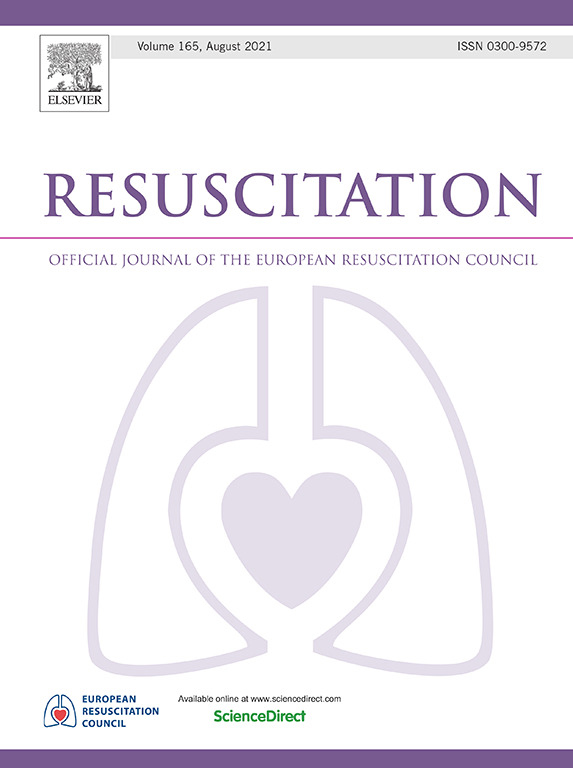复苏后12导联心电图特征与院外心脏骤停后长期神经预后之间的关系:PEACE研究的事后亚分析
IF 4.6
1区 医学
Q1 CRITICAL CARE MEDICINE
引用次数: 0
摘要
院外心脏骤停(OHCA)在世界范围内的存活率很低。对于诊断引起OHCA的急性冠状动脉综合征以及确定有资格立即进行冠状动脉造影的患者,自发循环心电图(post-ROSC ECG)的恢复是至关重要的。然而,尚不清楚rosc后心电图特征是否也可作为预后预测的合理特征。方法本回顾性研究分析了2015年1月至2018年12月期间在维也纳(奥地利)、帕维亚(意大利)和卢加诺(瑞士)三个参与中心之一入院的成人非创伤性OHCA患者的rosc后心电图,并报告了心电图特征、生存和神经系统预后(出院时和一年后)。单变量和多变量逻辑回归评估了心电图特征和神经预后之间的关联。结果53.5%的rosc后心电图诊断为stemi。68.1%的患者出院,59.5%的患者神经系统预后良好。一年后,61.6%的非STEMI患者预后良好,而STEMI患者的这一比例为54%。单变量分析表明,II期、III期和aVF期st段升高以及更广泛的QRS复合物显著影响一年后的神经预后。结论ROSC术后secg比其他预后方法更早发现OHCA术后死亡高危患者,不仅在短期死亡率方面,而且在OHCA术后1年的神经预后方面。较宽的QRS复合物和II、III或aVF的st段升高被认为是特定的预后因素。本文章由计算机程序翻译,如有差异,请以英文原文为准。
Association between postresuscitation 12-lead ECG features and long-term neurological outcome after out-of-hospital cardiac arrest: a post-hoc subanalysis of the PEACE study
Background
Out-of-hospital cardiac arrest (OHCA) has low survival rates worldwide. For the diagnosis of acute coronary syndrome causing OHCA and the identification of patients eligible for immediate coronary angiography, the post-return of spontaneous circulation electrocardiogram (post-ROSC ECG) is crucial. However, it is still unclear whether post-ROSC ECG features also pose a sensible feature for outcome prediction.
Methods
This retrospective study analysed adult non-traumatic OHCA cases with post-ROSC ECGs admitted to one of the three participating centers in Vienna (Austria), Pavia (Italy) and Lugano (Switzerland) between 01/2015 and 12/2018, and reports ECG features, survival and neurological outcome (at hospital discharge and after one year). Univariable and multivariable logistic regression assessed associations between ECG features and neurological outcome.
Results
STEMI was diagnosed in 53.5% of post-ROSC ECGs. 68.1% of patients were discharged, with 59.5% having a favorable neurological outcome. One year later, 61.6% of non-STEMI patients had a favorable outcome compared to 54% of STEMI patients. Univariable analysis indicated that ST-elevations in II, III, and aVF, as well as a broader QRS complex significantly influenced neurological outcomes at one year.
Conclusions
ECG after ROSC can identify patients at high risk of death after OHCA earlier than other prognostic methods, not only in terms of short-term mortality, but also in terms of neurological outcome one year after OHCA. Wider QRS complex and ST-elevations in II, III, or aVF were identified as specific prognosticators.
求助全文
通过发布文献求助,成功后即可免费获取论文全文。
去求助
来源期刊

Resuscitation
医学-急救医学
CiteScore
12.00
自引率
18.50%
发文量
556
审稿时长
21 days
期刊介绍:
Resuscitation is a monthly international and interdisciplinary medical journal. The papers published deal with the aetiology, pathophysiology and prevention of cardiac arrest, resuscitation training, clinical resuscitation, and experimental resuscitation research, although papers relating to animal studies will be published only if they are of exceptional interest and related directly to clinical cardiopulmonary resuscitation. Papers relating to trauma are published occasionally but the majority of these concern traumatic cardiac arrest.
 求助内容:
求助内容: 应助结果提醒方式:
应助结果提醒方式:


